
Jackie Saccoccio was born in Providence, RI, and received her MFA from The Art Institute of Chicago in 1988. She is currently living and working at the American Academy in Rome, along with her husband and current Fellow Carl D'Alvia. She was a Rome Prize recipient in 2005 and was awarded a Guggenheim in 2000. She had a highly regarded 2012 show, "Portraits," at Eleven Rivington, New York, and has forthcoming shows at the Nerman Museum of Contemporary Art, Kansas City later this spring, and the Museo d'Arte Contemporanea in Genova, Italy in 2014.
This is an abridged version of our correspondence about her process, recent shifts, influences, and working in Rome.
The full interview can be read on Burnaway.
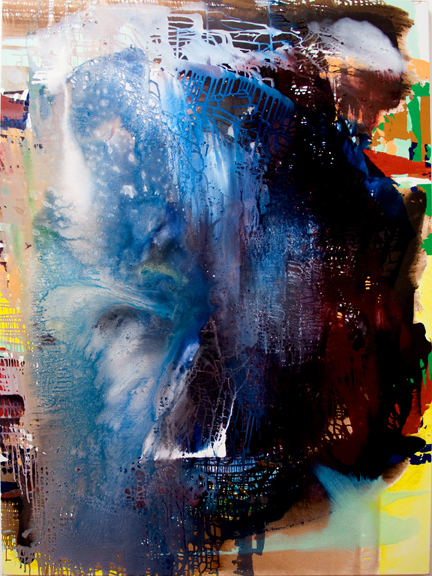
Portrait: Beast, 2013, 106 x 79", courtesy the artist and Eleven Rivington, NY.
As a viewer, it's almost impossible to retrace your steps. For starters, how do you go about making your paintings? They can feel so disorienting, difficult to pin down visually.
I use paint in varying degrees of liquidity and apply layer upon layer, with anywhere from 10-50 plus passes. It's an additive occupation. I mean, I cover things, but I rarely edit or wipe off. I want the canvas to record the entire passage of the painting experience, including whatever self-doubt and bravado that went into its making. I guess that's my nod to Malcolm Morley. Using the trope of photo-realist gridding, he executed such tremendous temporal evocations, with each grid reflecting the gestural experience of the moment, so that the end product is as much a painting of a ship as it is a record of the daily shifts in expression/execution -- a psychological form of cubism lain out in a grid form.
The disorientation may be initiated by my approaching the canvasses as sculptures. When making "One to One" (a site-specific 15' painting at Eleven Rivington in 2010), I recognized a shift in my attitude towards the mark-making. I wasn't developing passages toward a visually penetrable space, but building an object -- a wall in that case. Despite using paint and linen, that adjustment in my intent altered the end result considerably.
In the "Portraits" series (beginning in 2011), the presence of the object, the canvas, continues to override pictorial space. Its amplified by the big central mass. And now in Rome with its abundance of sculpture, it's being reinforced ten-fold. Odd, as I mean the sculpture has always been here, but my eyes weren't open to it.
There appeared to be a shift in how you think about painting space in around 2009... and maybe a transformation of material and canvas. Like alchemy or magic. Do you see the space of your recent work as being more experiential, virtual, and illusionistic?
Yeah, you're right. That's when the interest in alchemy began. After the "Interrupted Grid" show, the marks became larger. I was more interested in what was happening within the space of the mark, than relating it to other marks, like zooming in. That led to more and more experimentation with traditional materials, which also coincided with moving my studio to the country. There I had room to set up the studio more like a laboratory, to push the alchemical. Sounds benign, but my studio in Harlem was a small box, so I was limited to one large painting at a time. I couldn't let paintings percolate. I don't know -- besides the space issue, the patience required to make these works is not something I could find in when I was working in NYC.
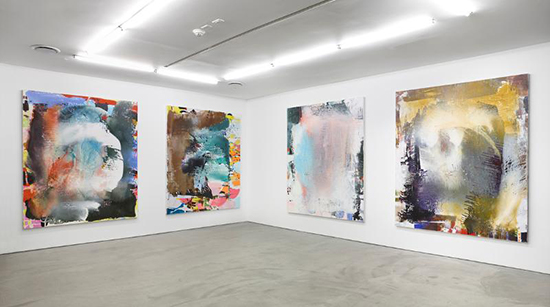
Installation view, 2012, Portraits, Eleven Rivington, NY
I love how unabashedly beautiful your work is, especially at a time when so much young abstraction deals in the language of the abject. It feels so joyous. The opulence delivers. I know you've used words like "rapture" in recent titles. I'm curious about your thoughts on transcendence in painting, either visual or spiritual. It seems to go further than a play with painting traditions.
Great questions, and interesting that you ask these together. I love these naughty issues of beauty, opulence and transcendence. Like the young painters that you mention, I went through great pains to eliminate traces of beauty in my painting, so as not to obfuscate the "serious" nature of my work, or so I thought... The result was that I sent all the wrong messages, and the response was disheartening. Now, as I'm more accepting of this beauty thing seeping into the paintings, it's not only not an issue, but viewers are more likely to bring up transcendence or ephemeral references, which has been my aim. The odd thing is, in those early years, I was making paintings with literal references to these. Now, in these portraits, with their mass and weight, they elicit ideas about impermanence.
In regards to seductive opulence in my painting, I am reminded of a point that Shakespeare scholar Stephen Greenblatt made at a lecture recently. He posited that the sheer beauty of the language in Lucretius' "On the Nature of Things," may have been responsible for the poem's clandestine survival throughout the centuries while it was publicly banned. It reappeared in 1417 on humanist Poggio Bracciolini's bookshelf, going on to inspire many. One such mellifluous phrase from Lucretius (via Greenblatt) that continues to run through my mind: "Honey smeared on the lip of a cup to make bitter medicine go down." I'd like to think that opulence could have such a noble purpose.
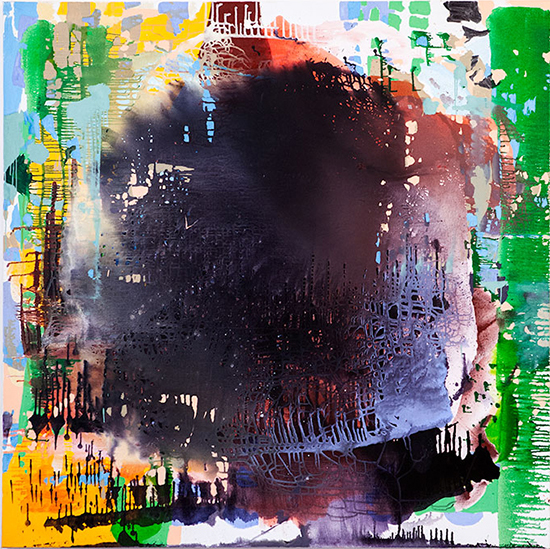
Portrait: Circus, 2013, 79 x 79", courtesy the artist and Eleven Rivington, NY.
It's really interesting that your work engages Ab-Ex romanticism and post-mark ideas about material/drips as image and emblem. The two impulses melt into something else altogether. Vast swaths of color become shifting planes, drips like extensive and drawn circuits, a collaging of space that almost feels digital. David Reed and Frankenthaler both feel like antecedents...or Richter and Rothko...or Lichtenstein and Turner -- you cross a lot of wires.
I sway more towards Polke than Richter, but Lichtenstein and Turner... Yes! Crossing wires does make for strange and delightful bedfellows. I think I've learned the most about Ab-Ex mark-making by studying Johns' Green Target, and Hudson River School painting through Pollack and Charles Burchfield. It sounds generic when I list a lot of artists whose work influences, but it's like mixing up some disparate -- you never know what can happen--nothing or everything. Last month it was Laurie Simmons and Ghirlandaio. Next week, Courbet and Rosemarie Trockel?
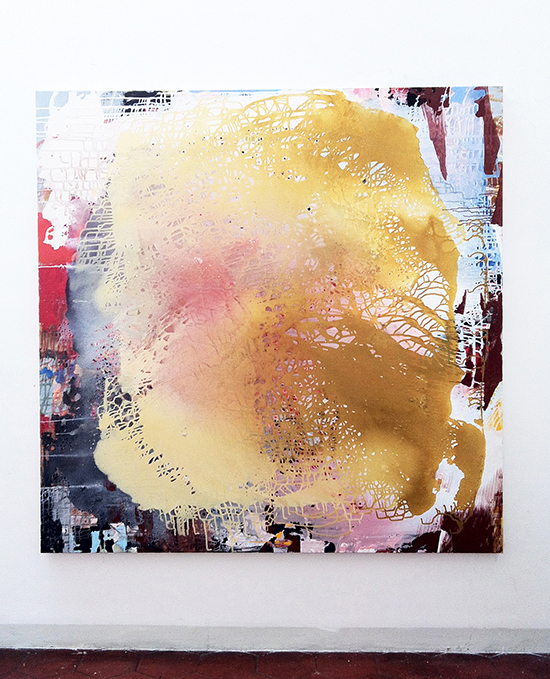
Portrait: Light, 2013, 79 x 79", courtesy the artist and Eleven Rivington, NY.
I know you've spent a lot of time in Rome throughout your life, and are there working now. I remember standing on the Gianicolo and marveling at the incomprehensibility of the city. It's like an enormous, sublime god-brain. I wonder if Rome itself, being there, has influenced the nature of your work.
Oh my god, yes! I assumed at the beginning of this year's term that I understood all that was Rome, but I was so wrong. My fascination was initially architecture, and trying to decipher how architects, Borromini, in particular, could create objects that shift into space, like Tony Smith's Moondog, as if the air is sucking them into a vortex landscape upward. I know that's not as clear as it could be, but I bring it up as a counterpoint to how this city appears to me now; all these chunks of solidity, the walls, the sculpture, humanity as opposed to something very ethereal. The room of Roman busts in the Capitoline Museum sort of defines it all.
Most importantly, what's your favorite place to get gelato?
Favorite gelato? The list is long. My daughter has been relentless in her research throughout Italy. Her top prize goes to Caffe' Sicilia in Noto, Sicily. For Rome, her fave is La Gelateria del Pigneto, a little artisanal hole in the wall with flavors like violet, rose and mango peach. For chocolate -- Venchi on via del Croce.
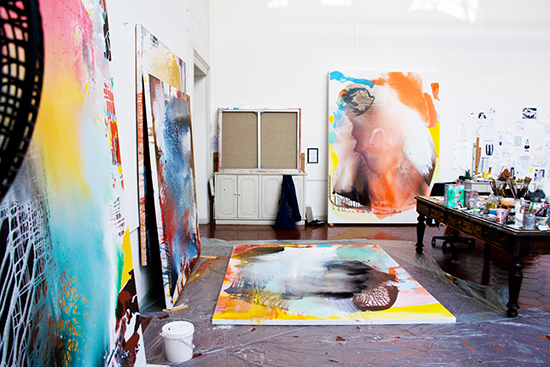
Studio view, Rome, courtesy the artist.